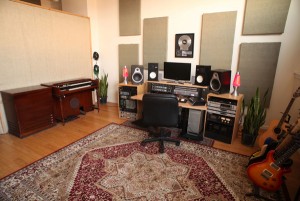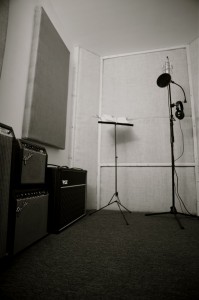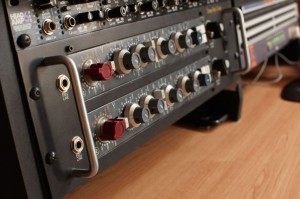Brooklyn’s Newest Studio: Anthony Gallo Opens Virtue and Vice for Production, Tracking, Mixing
GREENPOINT, BROOKLYN: There’s no substitute for experience, a fact that Anthony “Rocky” Gallo is taking firmly into account as he expands the buzzing Brooklyn studio scene by another degree. His addition to the Broken Land’s soundscape: Virtue and Vice, a just-right room that he’s growing in Greenpoint.
Gallo has set up shop as he exits his position of Chief Engineer at Manhattan’s Cutting Room Studios, his professional home since 2003 (he was also briefly partnered in Williamsburg’s 1.6 studios, before it changed ownership and became Three Egg). In the process of working with major names like John Legend, Carrie Underwood, Jon Bon Jovi, Yeasayer, The XX, and KRS1, along with scores of indie artists, Gallo became convinced that there was a need for a New York City tracking/mixing room that wasn’t too big, and wasn’t too small.
Instead of investing in a massive gear list, Gallo has stocked Virtue and Vice with a tight but superior inventory of the components he knows best, and wired them into a naturally light space that facilitates comfort and creative flow. Filling out 800 sq. ft. in a Greenpoint commercial loft building close to the L train, Rocky G believes V&V can excel and succeed in NYC.
What kind of space were you looking for to go into business?
The big thing to me was creating an accurate, great-sounding listening environment. I was looking for windows with good light, a very clean design and affordability. This building had all of those things — and I spent two or three years looking for a room before I settled on one.
My theory is that the old way of making records is completely dead: control rooms, live rooms, machine rooms…the way they did it for 40 years isn’t working any more. I wasn’t trying to create this super-isolated environment with a control room and a live room – instead there’s a large vocal booth with a large control/main space. I was talking to a colleague who said he thought that around $500 a day with engineer is the magic number, and that was my main goal.
In Brooklyn, that approach can work out well for my clients and for me – you can break even without having to be booked every day of the month. I also have two or three other guys that come in, and they can charge a little less if I’m working in Nashville. It’s a flexible thing.
What niche did you design Virtue and Vice to fill?
The reality is that artists spend a day or two doing drums — that’s what it’s been for most of the records I’ve done. So why spend money for a buildout and treatments for a room you’ll use one or two days a month? For the gear, it’s the same thing: I’m buying pres and compressors that will never go down in value. If you’re going to buy something, you should never have to say later on, “That was stupid.”
So really the idea is to get as clean of a signal as you can get for overdubs and guitar tracking. This is a place where you can set the amp up, run the speaker cable and actually hear what you’re doing — all the things you should be capable of that a lot of people ignore, as far as the indie market goes.
Good feng shui was obviously on the top of your mind when laying this studio out.
A mentor of mine told me once that a great couch can mean more than a $15,000 microphone. As sad as that is for me as a gear head, I’ll realize that that’s true, and I’ll stop myself from buying a new compressor all the time.
As soon as you can make a client feel that they’re not in a recording studio, and feel like they’re in a living room instead and completely relax, they can focus on doing work. The studio environment freaks people out. Back in the day, that was the office for studio musicians, but now it’s a rarity. Making records might happen more often, but a lot less time is spent in the process.
So I was going for a more comfortable environment, rather than saying I had three Telefunken microphones — it’s the reality that it doesn’t matter as much as the feel of the place. Not to say the equipment can’t be good, but I realized that where to put your energy was in a really clean, comfortable environment. Because 90% of the time the project will require one microphone – three tops – for overdubs.
You expect to be doing a lot of mixing here as well, right?
Mixing is most of the work that I do, as far as my clients go, but production, mixing, and overdubs are all my main personal workload. When it comes to mixing, for me the Dangerous 2-BUS has definitely added a huge dimension to the stereo image. I come out of Pro Tools HD3 into the Neve 1081 channels or compressors – which I use like a strip of the console — then back into the Dangerous again. The amount of clarity and overall fatness the combination creates was a huge, noticeable difference.
You’ve been steadily building up an impressive portfolio in NYC and beyond. What would you say is driving your evolution as an engineer/mixer?
The whole Manhattan music production scene has changed more in the last in the last year or two than in the previous twenty years. The way people are releasing and recording records is transforming: Now you can work in Pro Tools on your laptop without an interface. Five years ago that was never even thought of – you were carrying around an Mbox at least.
As far as my approach, I figured out how you can make a record for very little overhead, and still make it sound really great. You should be able to make a major release for $10-15K. Those live KEXP sessions at the Cutting Room really opened my eyes. Great bands like Yeasayer were coming in and saying, “This sounds better than the record,” and I was thinking, “I just spent 25 minutes on this, and you must have spent at least two months making your record. What’s wrong here?”
So you don’t need everything in the world — just experience and doing it time and time again. The theory is just you knowing what you want to hear in the end. I would love to work on a big console today, but I just started to realize you don’t need it. It’s really not important. And time after time I found myself using the desk less and less, based on the short amount of time I had with the client.
On that note, what type of clients are you appealing to with Virtue and Vice?
Pretty much any stage of their project. If someone’s looking to do a record and they hit us up, we’ll find a place to do the drums for the day. We take a strategic approach to production, rather than saying, “Show up for your first day, we’ll set mics up, and see what happens.”
As a staff engineer, for example, I was constantly seeing that people were coming in with problematic drums – they didn’t have their time signature noted, their tempos weren’t set, etc…. I’d rather go over that with my clients in advance, because it will make things challenging for me if I’m the one mixing it down the road. I think the best thing to do is spend some time before you come in, so you make the right decisions before you go in to work.
Overall, the target audience is someone working on a budget, but who still needs to make something really great. I know I’m not the cheapest, but I definitely have the experience and probably work faster than most people, being the product of a Manhattan studio. When your client is getting charged up to $175 an hour you have to be fast and not think twice about what you’re doing. And that’s how I was trained.
You had your choice of boroughs and neighborhoods to set out a shingle. What’s going on in Greenpoint that made you select it as the home for Virtue and Vice?
A lot of my colleagues are in Manhattan and they’re saying to me, “You’re going to have trouble getting people out here (in Greenpoint).” Some of them say it’s like going to New Jersey, but I tell them that all my clients live out there.
The only people still living in Manhattan are label heads, and how much longer will they be working at that label? The clientele has really moved out here, and the people that have been making music here for the last ten years are growing up, and getting much more developed in what they’re creating. The people doing this for a living are not afraid to spend money to get the right person to do the job. Young guys see how it’s going, and how records as are being made.
Brooklyn’s Greenpoint and Bushwick areas are becoming a mecca for making music: The artists are there, and the studios are there because it’s less expensive to operate. The whole Manhattan recording scenario to me seems bizarre: high rent and a small room to work in. The people who are doing volume recoding are out in Brooklyn. There’s a lot of great places coming up, with guys coming from Manhattan studios who are super-experienced and putting together really tight rooms, like Kevin Blackler who came from Sony (and established Blackler Mastering in Brooklyn). I think the mastering guys like him have it the best, because they can be anywhere.
There are a lot of options already for artists and producers working at that level you just mentioned, as we’re sure you aware. What made you decide to look past that and open another NYC audio facility?
My next door neighbor across the hall is doing the same thing in his off-time, and when I moved into this building, he basically said the same thing, “Another studio?” I said, “I know…” But this is not a hobby for me. This is the way I live. It’s the way I purchased my equipment: I didn’t give up my old job and make a bunch of miscellaneous purchases with my severance package. I learned how to make records from guys doing it for 20 years, and then I made records in order to buy this gear.
Yes, it seems like the market is flooded with studio choices. and I know a lot of great guys are getting out of doing it, because its flooded with more kids coming out of recording school than there are bands to record, and the young kids are the ones doing it for a six-pack and a pizza. It’s a funny thing, how many people are opening up studios: They think it’s affordable — that they can charge $300 a day in exchange for making an investment of $15,000 and make it right back.
But it’s not an easy job, and it’s not for somebody who’s in it for the short term. I think I’m finally getting a real grasp of what to do and how to do it, and I’m talking to people who have been doing it for 25 years who are getting their minds blown with the recent developments, and changing what they’re doing.
There’s always been people who are good talkers and will get the gig, but this is a long, slow, steady course. The more you put in, the more you’ll get out of it, and the better records you’ll make. That’s the best way to approach it.
— David Weiss










Meghan Teed
February 6, 2012 at 8:14 pm (13 years ago)Nice TJ!!!!!!!!!!!!